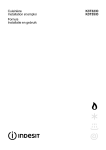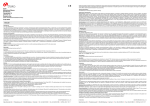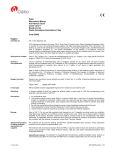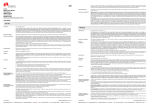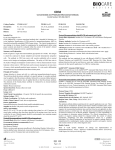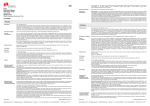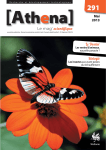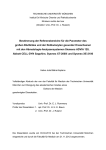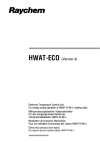Download FLEX Monoclonal Mouse Anti-Human CD34 Class II Clone
Transcript
evaluating pathologist should desire a different staining intensity, a Dako Application Specialist/Technical Service Specialist can be contacted for information on re-programming of the protocol. Verify that the performance of the adjusted protocol is still valid by evaluating that the staining pattern is identical to the staining pattern described in “Performance characteristics”. FLEX Monoclonal Mouse Anti-Human CD34 Class II Clone QBEnd 10 Ready-to-Use (Dako Autostainer/Autostainer Plus) Counterstaining in hematoxylin is recommended using EnVision FLEX Hematoxylin (Dako Autostainer/Autostainer Plus) (Code K8018). Non-aqueous, permanent mounting medium is recommended. Positive and negative controls should be run simultaneously using the same protocol as the patient specimens. The positive control tissue should include liver and the cells/structures should display reaction patterns as described for this tissue in “Performance characteristics” in all positive specimens. The recommended negative control reagent is FLEX Negative Control, Mouse (Dako Autostainer/Autostainer Plus) (Code IS750). Code IS632 Staining interpretation The cellular staining pattern is membranous. Performance characteristics Normal tissues: The antibody labels capillaries of most tissues as well as umbilical artery and, to a lesser extent, vein. The antibody does not label endothelium of most large vessels and the endothelium of placental sinuses (8). Abnormal tissues: A total of 112 vascular tumors, 54 carcinomas of different types and 45 non-vascular spindle cell tumors were stained with anti-CD34, clone QBEnd-10 (2). All (22/22) the benign tumors of blood vascular origin showed immunoreactivity whereas only five out of eight lymphangiomas demonstrated a weak focal reaction with QBEnd-10 (2). Tumor cells in angiosarcoma forming vasoformative areas and solid areas showed immunopositivity to QBEnd-10 in 17/23 and 13/24 cases, respectively (2). Proliferating vessels and the majority of spindle cells in Kaposi’s sarcoma were positive in all 40 cases. Only one of 54 cases of carcinoma showed luminal reaction to QBend-10. However, 17 of 45 spindle cell tumors displayed a positive reaction (2). ENGLISH Intended use For in vitro diagnostic use. FLEX Monoclonal Mouse Anti-Human CD34 Class II, Clone QBEnd 10, Ready-to-Use, (Dako Autostainer/ Autostainer Plus), is intended for use in immunohistochemistry together with Dako Autostainer/Autostainer Plus instruments. This antibody is useful for the identification of vascular and lymphatic tumors and for the subclassification of leukemias (1-3). The clinical interpretation of any staining or its absence should be complemented by morphological studies using proper controls and should be evaluated within the context of the patient's clinical history and other diagnostic tests by a qualified pathologist. Summary and explanation CD34 is a single-chain transmembrane protein of approximately 116 kDa. CD34 is expressed on immature haematopoietic stem/progenitor cells, capillary endothelial cells, embryonic fibroblasts and rare glial cells in nervous tissue (4, 5). CD34 appears to be expressed at its highest level on the earliest progenitors, and to decrease progressively with maturation (6, 7). CD34 is a stage-specific, rather than a lineage-specific, leucocyte differentiation antigen. The most immature definable B-lymphoid precursors (CD19+/CD10+/TdT+) are CD34+ (5-7). Immature T-lymphoid precursors also express TdT and CD34 (5). Normal peripheral blood lymphocytes, monocytes, granulocytes, and platelets do not express CD34. Approximately 60% of acute B-lymphoid leukaemias and 40% of acute myeloid leukaemias (AML), and 1% to 5% of acute T-lymphoid leukaemias express CD34 (7). Chronic lymphoid leukaemias, lymphomas and multiple myelomas have been found to be uniformly CD34 negative (4-7). Monoclonal antibodies to CD34 can be confined to three main classes, class I, class II and class III, defined by the differential sensitivity of the corresponding CD34 epitopes to degradation by specific enzymes. The QBEnd 10 antibody is a class II monoclonal antibody that recognizes a CD34 epitope that is resistant to neuraminidase, and sensitive to glycoprotease and chymopapain (4, 7, 8). Refer to Dako’s General Instructions for Immunohistochemical Staining or the detection system instructions of IHC procedures for: 1) Principle of Procedure, 2) Materials Required, Not Supplied, 3) Storage, 4) Specimen Preparation, 5) Staining Procedure, 6) Quality Control, 7) Troubleshooting, 8) Interpretation of Staining, 9) General Limitations. Reagent provided Ready-to-use monoclonal mouse antibody provided in liquid form in a buffer containing stabilizing protein and 0.015 mol/L NaN3. Clone: QBEnd 10. Isotype: IgG1, kappa. Immunogen Endothelial cell membranes obtained as vesicles from human placenta (6, 8). Specificity Anti-CD34, QBEnd 10, was included in the Fourth and Fifth International Workshops and Conferences on Human Leucocyte Differentiation Antigens, and studies by different laboratories confirmed its reactivity with the CD34 antigen (6, 8) and the class II epitope (8). In formalin-fixed, paraffin embedded tonsil sections the antibody labels endothelial cells. Precautions 1. For professional users. 2. This product contains sodium azide (NaN3), a chemical highly toxic in pure form. At product concentrations, though not classified as hazardous, sodium azide may react with lead and copper plumbing to form highly explosive build-ups of metal azides. Upon disposal, flush with large volumes of water to prevent metal azide build-up in plumbing. 3. As with any product derived from biological sources, proper handling procedures should be used. 4. Wear appropriate Personal Protective Equipment to avoid contact with eyes and skin. 5. Unused solution should be disposed of according to local, State and Federal regulations. Storage Store at 2-8 °C. Do not use after expiration date sta mped on vial. If reagents are stored under any conditions other than those specified, the conditions must be verified by the user. There are no obvious signs to indicate instability of this product. Therefore, positive and negative controls should be run simultaneously with patient specimens. If unexpected staining is observed which cannot be explained by variations in laboratory procedures and a problem with the antibody is suspected, contact Dako Technical Support. Specimen preparation including materials required but not supplied Staining procedure including materials required but not supplied The antibody can be used for labeling formalin-fixed, paraffin-embedded tissue sections. Tissue specimens should be cut into sections of approximately 4 µm. Pre-treatment with heat-induced epitope retrieval (HIER) is required using Dako PT Link (Code PT100/PT101). For details, please refer to the PT Link User Guide. Optimal results are obtained by pretreating tissues using EnVision FLEX Target Retrieval Solution, High pH (50x) (Code K8010/K8004). Paraffin-embedded sections: Pre-treatment of formalin-fixed, paraffin-embedded tissue sections is recommended using the 3-in-1 specimen preparation procedure for Dako PT Link. Follow the pre-treatment procedure outlined in the package insert for EnVision FLEX Target Retrieval Solution, High pH (50x) (Code K8010/K8004). Note: After staining the sections must be dehydrated, cleared and mounted using permanent mounting medium. Deparaffinized sections: Pre-treatment of deparaffinized formalin-fixed, paraffin-embedded tissue sections is recommended using Dako PT Link and following the same procedure as described for paraffin-embedded sections. After staining the slides should be mounted using aqueous or permanent mounting medium. The tissue sections should not dry out during the treatment or during the following immunohistochemical staining procedure. For greater adherence of tissue sections to glass slides, the use of FLEX IHC Microscope Slides (Code K8020) is recommended. The recommended visualization system is EnVision FLEX, High pH (Dako Autostainer/Autostainer Plus) (Code K8010). The staining steps and incubation times are pre-programmed into the software of Dako Autostainer/Autostainer Plus instruments, using the following protocols: Template protocol: FLEXRTU2 (200 µL dispense volume) or FLEXRTU3 (300 µL dispense volume) Autoprogram: CD34 (without counterstaining) or CD34H (with counterstaining) FRANÇAIS Utilisation prévue Pour utilisation diagnostique in vitro. FLEX Monoclonal Mouse Anti-Human CD34 Class II, clone QBEnd 10, Ready-to-Use, (Dako Autostainer/ Autostainer Plus), est destiné à une utilisation en immunohistochimie avec les instruments Dako Autostainer/ Autostainer Plus. Cet anticorps facilite l’identification des tumeurs vasculaires et lymphatiques et la sous-classification des leucémies (1–3). L’interprétation clinique de toute coloration ou son absence doit être complétée par des études morphologiques en utilisant des contrôles appropriés et doit être évaluée en fonction des antécédents cliniques du patient et d’autres tests diagnostiques par un pathologiste qualifié. Résumé et explication Le CD34 est une protéine transmembranaire à simple chaîne d’environ 116 kDa. Le CD34 est exprimé sur les cellules souches/progéniteurs hématopoïétiques immatures, les cellules endothéliales des capillaires, les fibroblastes embryonnaires et quelques rares cellules gliales du tissu nerveux (4, 5). L’expression du CD34 semble être maximale sur les progéniteurs les plus précoces et diminue progressivement avec la maturation (6, 7). Le CD34 est un antigène de différenciation des leucocytes spécifique à un stade plutôt qu’à une lignée. Les précurseurs lymphoïdes B définissables les plus immatures (CD19+/CD10+/TdT+) sont CD34+ (5-7). Les précurseurs lymphoïdes T immatures expriment également la TdT et le CD34 (5). Les lymphocytes, les monocytes, les granulocytes et les plaquettes du sang périphérique normal n’expriment pas le CD34. Environ 60 % des leucémies à lymphocytes B aiguës, 40 % des leucémies aiguës myéloïdes (LAM) et 1 à 5 % des leucémies à lymphocytes T aiguës expriment le CD34 (7). On constate que les leucémies lymphoïdes chroniques, les lymphomes et plusieurs types de myélomes présentent un résultat uniformément négatif au CD34 (4-7). Les anticorps monoclonaux dirigés contre le CD34 peuvent être restreints à trois classes principales, classe I, classe II et classe III, définis par la sensibilité différentielle des épitopes du CD34 correspondant à la dégradation par des enzymes spécifiques. L’anticorps QBEnd 10 est un anticorps monoclonal de classe II qui reconnaît un épitope du CD34 qui est résistant à la neuraminidase, et sensible à la glycoprotéase et à la chymopapaïne (4, 7, 8). Se référer aux Instructions générales de coloration immunohistochimique de Dako ou aux instructions du système de détection relatives aux procédures IHC pour plus d’informations concernant les points suivants : 1) Principe de procédure, 2) Matériels requis mais non fournis, 3) Conservation, 4) Préparation des échantillons, 5) Procédure de coloration, 6) Contrôle qualité, 7) Dépannage, 8) Interprétation de la coloration, 9) Limites générales. Réactifs fournis Anticorps monoclonal de souris prêt à l’emploi fourni sous forme liquide dans un tampon contenant une protéine stabilisante et 0,015 mol/L d’azide de sodium. Clone : QBEnd 10. Isotype : IgG1, kappa. Immunogène Les membranes cellulaires endothéliales obtenues comme vésicules à partir de placenta humain (6, 8). Spécificité L’anti-CD34, QBEnd 10, a été inclus lors des Fourth and Fifth International Workshops and Conferences on Human Leucocyte Differentiation Antigens (Quatrième et Cinquième Conférences et Ateliers Internationaux sur les Antigènes de Différenciation des Leucocytes Humains (HLDA)). Des études réalisées par différents laboratoires ont également confirmé sa réactivité à l’antigène du CD34 (6, 8) et à l’épitope de classe II (8). Dans les coupes d’amygdale fixées au formol et incluses en paraffine, l’anticorps marque les cellules endothéliales. Précautions 1. Pour utilisateurs professionnels. 2. Ce produit contient de l’azide de sodium (NaN3), produit chimique hautement toxique dans sa forme pure. Aux concentrations du produit, bien que non classé comme dangereux, l’azide de sodium peut réagir avec le cuivre et le plomb des canalisations et former des accumulations d’azides métalliques hautement explosifs. Lors de l’élimination, rincer abondamment à l’eau pour éviter toute accumulation d’azide métallique dans les canalisations. 3. Comme avec tout produit d’origine biologique, des procédures de manipulation appropriées doivent être respectées. 4. Porter un vêtement de protection approprié pour éviter le contact avec les yeux et la peau. 5. Les solutions non utilisées doivent être éliminées conformément aux réglementations locales et nationales. Conservation Conserver entre 2 et 8 °C. Ne pas utiliser après la date de péremption indiquée sur le flacon. Si les réactifs sont conservés dans des conditions autres que celles indiquées, celles-ci doivent être validées par l’utilisateur. Il n’y a aucun signe évident indiquant l’instabilité de ce produit. Par conséquent, des contrôles positifs et négatifs doivent être testés en même temps que les échantillons de patient. Si une coloration inattendue est observée, qui ne peut être expliquée par un changement des procédures du laboratoire, et en cas de suspicion d’un problème lié à l’anticorps, contacter l’assistance technique de Dako. Préparation des échantillons y compris le matériel requis mais non fourni L’anticorps peut être utilisé pour le marquage des coupes de tissus inclus en paraffine et fixés au formol. L’épaisseur des coupes d’échantillons de tissu doit être d’environ 4 µm. Un prétraitement avec démasquage d’épitope induit par la chaleur (HIER) est nécessaire avec le Dako PT Link (Réf. PT100/PT101). Pour plus de détails, se référer au Guide d’utilisation du PT Link. Des résultats optimaux sont obtenus en prétraitant les tissus à l’aide de la EnVision FLEX Target Retrieval Solution, High pH (50x) (Réf. K8010/K8004). Coupes incluses en paraffine : le prétraitement des coupes tissulaires fixées au formol et incluses en paraffine est recommandé à l'aide de la procédure de préparation d'échantillon 3-en-un pour le Dako PT Link. Suivre la procédure de prétraitement indiquée dans la notice de la EnVision FLEX Target Retrieval Solution, High pH (50x) (Réf. K8010/K8004). Remarque : après coloration, les coupes doivent être déshydratées, lavées et montées à l’aide d’un milieu de montage permanent. Coupes déparaffinées : le prétraitement des coupes tissulaires déparaffinées, fixées au formol et incluses en paraffine, est recommandé à l’aide du Dako PT Link, en suivant la même procédure que pour les coupes incluses en paraffine. Après coloration, un montage aqueux ou permanent des lames est recommandé. The Auxiliary step should be set to “rinse buffer” in staining runs with ≤10 slides. For staining runs with >10 slides the Auxiliary step should be set to “none”. This ascertains comparable wash times. All incubation steps should be performed at room temperature. For details, please refer to the Operator’s Manual for the dedicated instrument. If the protocols are not available on the used Dako Autostainer platform, please contact Dako Technical Services. Optimal conditions may vary depending on specimen and preparation methods, and should be determined by each individual laboratory. If the (115311-002) Dako Denmark A/S IS632/EFG/MNI/2009.12.04 p. 1/4 | Produktionsvej 42 | DK-2600 Glostrup | Denmark | Tel. +45 44 85 95 00 | Fax +45 44 85 95 95 | CVR No. 33 21 13 17 (115311-002) Dako Denmark A/S IS632/EFG/MNI/2009.12.04 p. 2/4 | Produktionsvej 42 | DK-2600 Glostrup | Denmark | Tel. +45 44 85 95 00 | Fax +45 44 85 95 95 | CVR No. 33 21 13 17 Les coupes de tissus ne doivent pas sécher lors du traitement ni lors de la procédure de coloration immunohistochimique suivante. Pour une meilleure adhérence des coupes de tissus sur les lames de verre, il est recommandé d’utiliser des lames FLEX IHC Microscope Slides (Réf. K8020). Procédure de coloration y compris le matériel requis mais non fourni Interprétation de la coloration Le schéma de coloration cellulaire est membranaire. Caractéristiques de performance Tissus sains : L’anticorps marque les capillaires de la plupart des tissus ainsi que l’artère et, dans une moindre mesure, la veine ombilicale. L’anticorps ne marque pas l’endothélium de la plupart des gros vaisseaux et l’endothélium des sinus placentaires (8). Tissus tumoraux : Au total, 112 tumeurs vasculaires, 54 carcinomes de différents types et 45 tumeurs à cellules fusiformes non vasculaires ont été marqués par l’anti-CD34, clone QBEnd 10 (2). Toutes (22/22) les tumeurs bénignes d’origine vasculaire sanguine ont présenté une immunoréactivité alors que seulement cinq des huit lymphangiomes ont présenté une réaction faible et localisée au QBEnd 10 (2). Les cellules tumorales de l’angiosarcome formant des zones vasoformatives et des zones denses ont présenté une immunopositivité au QBEnd 10 dans 17 cas sur 23 et 13 cas sur 24, respectivement (2). Les vaisseaux proliférant et la majorité des cellules fusiformes du sarcome de Kaposi étaient positifs dans chacun des 40 cas. Un seul des 54 cas de carcinome a présenté une réaction luminale au QBend 10. Cependant, 17 des 45 tumeurs à cellules fusiformes ont présenté une réaction positive (2). DEUTSCH Zweckbestimmung Zur In-vitro-Diagnostik. FLEX Monoclonal Mouse Anti-Human CD34 Class II, Clone QBEnd 10, Ready-to-Use, (Dako Autostainer/Autostainer Plus) ist zur Verwendung in der Immunhistochemie in Verbindung mit Dako Autostainer/Autostainer Plus-Geräten bestimmt. Dieser Antikörper dient zur Erkennung vaskulärer und lymphatischer Tumore und für die Aufschlüsselung von Leukämien (1–3). Die klinische Auswertung einer eventuell eintretenden Färbung sollte durch morphologische Studien mit geeigneten Kontrollen ergänzt werden und von einem qualifizierten Pathologen unter Berücksichtigung der Krankengeschichte und anderer diagnostischer Tests des Patienten vorgenommen werden. Zusammenfassung und Erklärung CD34 ist ein einkettiges Transmembranprotein von ca. 116 kDa. CD34 wird auf unreifen hämatopoietischen Stamm- bzw. Vorläuferzellen, kapillaren Endothelzellen, embryonischen Fibroblasten und seltenen Gliazellen im Nervengewebe exprimiert (4, 5). Die höchsten Konzentrationen von CD34 scheinen von den frühesten Vorläuferzellen exprimiert zu werden, wobei die Expression mit der Reifung immer weiter abnimmt (6, 7). CD34 ist ein zustandsspezifisches und weniger ein reihenspezifisches Antigen zur Leukozytendifferenzierung. Die unreifsten definierbaren B-Lymphoid-Vorläufer (CD19+/CD10+/TdT+) sind CD34+ (5–7). Unreife T-LymphoidVorläufer exprimieren auch TdT und CD34 (5). Gesunde periphere Lymphozyten, Monozyten, Granulozyten und Plättchen im Blut exprimieren kein CD34. CD34 wird in etwa 60 % der Fälle von akuten B-lymphoiden Leukämien, 40 % der akuten myeloischen Leukämien (AML) sowie 1 % bis 5 % der akuten T-lymphoiden Leukämien exprimiert (7). Chronisch lymphoide Leukämien, Lymphome und multiple Myelome waren durchweg CD34-negativ (4–7). Monoklonale Antikörper gegen CD34 lassen sich in die drei Hauptklassen I, II und III einteilen – je nach der unterschiedlichen Empfindlichkeit der zugehörigen CD34-Epitope zum Abbau durch spezifische Enzyme. Der QBEnd-10-Antikörper ist ein monoklonaler Antikörper der Klasse II zum Nachweis eines CD34-Epitops, das resistent gegenüber Neuraminidase, jedoch empfindlich gegenüber Glykoprotease und Chymopapain ist (4, 7, 8). Folgende Angaben bitte den Allgemeinen Richtlinien zur immunhistochemischen Färbung von Dako oder den Anweisungen des Detektionssystems für IHC-Verfahren entnehmen: 1) Verfahrensprinzip, 2) Erforderliche, aber nicht mitgelieferte Materialien, 3) Aufbewahrung, 4) Vorbereitung der Probe, 5) Färbeverfahren, 6) Qualitätskontrolle, 7) Fehlersuche und -behebung, 8) Auswertung der Färbung, 9) Allgemeine Beschränkungen. Geliefertes Reagenz Gebrauchsfertiger, monoklonaler Maus-Antikörper in flüssiger Form in einem Puffer, der stabilisierendes Protein und 0,015 mol/L NaN3 enthält. Klon: QBEnd 10. Isotyp: IgG1, Kappa. Immunogen Aus Vesikeln der menschlichen Plazenta gewonnene Endothelzellmembranen (6, 8). Spezifität Anti-CD34, QBEnd 10 war ein Thema bei den Fourth and Fifth International Workshops and Conferences on Human Leucocyte Differentiation Antigens (4. und 5. Internationale(r) Workshop und Konferenz über menschliche Leukozyten differenzierende Antigene). Studien verschiedener Labors bestätigten die Reaktivität mit dem CD34-Antigen (6, 8) und dem Epitop der Klasse II (8). In formalinfixierten, paraffineingebetteten Mandelschnitten markiert der Antikörper Endothelzellen. Lagerung (115311-002) Dako Denmark A/S Der Antikörper eignet sich zur Markierung von formalinfixierten und paraffineingebetteten Gewebeschnitten. Gewebeproben sollten in Schnitte von ca. 4 µm Stärke geschnitten werden. Die Vorbehandlung durch hitzeinduzierte Epitopdemaskierung (HIER) mit Dako PT Link (Code-Nr. PT100/PT101) ist erforderlich. Weitere Informationen hierzu siehe PT Link-Benutzerhandbuch. Optimale Ergebnisse können durch Vorbehandlung der Gewebe mit EnVision FLEX Target Retrieval Solution, High pH (50x) (Code-Nr. K8010/K8004) erzielt werden. Paraffineingebettete Schnitte: Die Vorbehandlung der formalinfixierten, paraffineingebetteten Schnitte mit dem 3-in-1Probenvorbereitungsverfahren für Dako PT Link wird empfohlen. Vorbehandlung gemäß der Beschreibung in der Packungsbeilage für EnVision FLEX Target Retrieval Solution, High pH (50x) (Code-Nr. K8010/K8004) durchführen. Hinweis: Nach dem Färben müssen die Schnitte dehydriert, geklärt und mit permanentem Einbettmedium auf den Objektträger aufgebracht werden. Entparaffinierte Schnitte: Eine Vorbehandlung der entparaffinierten, formalinfixierten, paraffineingebetteten Gewebeschnitte mit Dako PT Link nach demselben Verfahren, wie für die paraffineingebetteten Schnitte beschrieben, wird empfohlen. Die Objektträger nach dem Färben mit einem wässrigen oder permanenten Einbettmedium bedecken. Die Gewebeschnitte dürfen während der Behandlung oder des anschließenden immunhistochemischen Färbeverfahrens nicht austrocknen. Zur besseren Haftung der Gewebeschnitte an den Glasobjektträgern wird die Verwendung von FLEX IHC Microscope Slides (Code-Nr. K8020) empfohlen. Färbeverfahren und erforderliche, aber nicht mitgelieferte Materialien Das empfohlene Visualisierungssystem ist EnVision™ FLEX, High pH, (Dako Autostainer/Autostainer Plus) (Code-Nr. K8010). Die Färbeschritte und Inkubationszeiten sind in der Software der Dako Autostainer/Autostainer Plus-Geräte mit den folgenden Protokollen vorprogrammiert: Matrix-Protokoll: FLEXRTU2 (200 µL Abgabevolumen) oder FLEXRTU3 (300 µL Abgabevolumen) Autoprogram: CD34 (ohne Gegenfärbung) oder CD34H (mit Gegenfärbung) Bei Färbedurchläufen mit höchstens 10 Objektträgern sollte der „Zusatz“-Schritt auf „Pufferspülgang“ eingestellt werden. Für Färbedurchläufe mit mehr als 10 Objektträgern den „Zusatz“-Schritt auf „Keine“ einstellen. Dieses gewährleistet vergleichbare Waschzeiten. Alle Inkubationsschritte sollten bei Raumtemperatur durchgeführt werden. Nähere Einzelheiten bitte dem Benutzerhandbuch für das jeweilige Gerät entnehmen. Wenn die Färbeprotokolle auf dem verwendeten Dako Autostainer-Gerät nicht verfügbar sind, bitte den Technischen Kundendienst von Dako verständigen. Le système de visualisation recommandé est le EnVision FLEX, High pH (Dako Autostainer/ Autostainer Plus) (Réf. K8010). Les étapes de coloration et d’incubation sont préprogrammées dans le logiciel des instruments Dako Autostainer/Autostainer Plus, à l’aide des protocoles suivants : Protocole modèle : FLEXRTU2 (volume de distribution de 200 µL) ou FLEXRTU3 (volume de distribution de 300 µL) Autoprogram : CD34 (sans contre-coloration) ou CD34H (avec contre-coloration) L’étape Auxiliary doit être réglée sur « rinse buffer » lors des cycles de coloration avec ≤10 lames. Pour les cycles de coloration de >10 lames, l’étape Auxiliary doit être réglée sur « none ». Cela garantit des temps de lavage comparables. Toutes les étapes d’incubation doivent être effectuées à température ambiante. Pour plus de détails, se référer au Manuel de l’opérateur spécifique à l'instrument. Si les protocoles ne sont pas disponibles sur la plateforme Dako Autostainer utilisée, contacter le service technique de Dako. Les conditions optimales peuvent varier en fonction du prélèvement et des méthodes de préparation, et doivent être déterminées par chaque laboratoire individuellement. Si le pathologiste qui réalise l’évaluation désire une intensité de coloration différente, un spécialiste d’application/spécialiste du service technique de Dako peut être contacté pour obtenir des informations sur la re-programmation du protocole. Vérifier que l'exécution du protocole modifié est toujours valide en vérifiant que le schéma de coloration est identique au schéma de coloration décrit dans les « Caractéristiques de performance ». Il est recommandé d’effectuer une contre-coloration à l’aide de EnVision™ FLEX Hematoxylin, (Link) (Réf. K8008). L’utilisation d’un milieu de montage permanent non aqueux est recommandée. Des contrôles positifs et négatifs doivent être réalisés en même temps et avec le même protocole que les échantillons du patient. Le contrôle de tissu positif doit comprendre le foie et les cellules/structures doivent présenter des schémas de réaction tels que décrits pour ces tissus dans les « Caractéristiques de performance » pour tous les échantillons positifs. Le contrôle négatif recommandé est le FLEX Negative Control, Mouse, (Link) (Réf. IR750). Vorsichtsmaßnahmen Vorbereitung der Probe und erforderliche, aber nicht mitgelieferte Materialien Optimale Bedingungen können je nach Probe und Präparationsverfahren unterschiedlich sein und sollten vom jeweiligen Labor selbst ermittelt werden. Falls der beurteilende Pathologe eine andere Färbungsintensität wünscht, kann ein Anwendungsspezialist oder Kundendiensttechniker von Dako bei der Neuprogrammierung des Protokolls helfen. Die Leistung des angepassten Protokolls muss verifiziert werden, indem gewährleistet wird, dass das Färbemuster mit dem unter „Leistungsmerkmale“ beschriebenen Färbemuster identisch ist. Die Gegenfärbung in Hämatoxylin sollte mit EnVision™ FLEX Hematoxylin, (Dako Autostainer/Autostainer Plus) (Code-Nr. K8018) ausgeführt werden. Empfohlen wird ein nichtwässriges, permanentes Fixiermittel. Positiv- und Negativkontrollen sollten zur gleichen Zeit und mit demselben Protokoll wie die Patientenproben getestet werden. Das positive Kontrollgewebe sollte Lebergewebe enthalten, und die Zellen/Strukturen müssen in allen positiven Proben die für dieses Gewebe unter „Leistungsmerkmale“ beschriebenen Reaktionsmuster aufweisen. Das empfohlene Negativ-Kontrollreagenz ist FLEX Negative Control, Mouse (Dako Autostainer/Autostainer Plus) (Code-Nr. IS750). Auswertung der Färbung Das zelluläre Färbemuster ist membranös. Leistungsmerkmale Gesundes Gewebe: Der Antikörper markiert Kapillaren der meisten Gewebe sowie Umbilikalarterien und, zu einem geringeren Anteil, Venen. Der Antikörper markiert keine Endothelien der meisten großen Gefäße und der Plazentahöhlen (8). Pathologisches Gewebe: Insgesamt 112 vaskuläre Tumore, 54 Karzinome verschiedener Typen und 45 nichtvaskuläre Spindelzelltumore wurden mit Anti-CD34, Klon QBEnd-10, angefärbt (2). Alle (22 von 22) benignen, aus Blutgefäßen stammenden Tumore zeigten Immunreaktivität, während nur fünf von acht Lymphangiomen eine schwache fokale Reaktion mit QBEnd-10 zeigten (2). Tumorzellen in Angiosarkomen, die vasoformative und feste Bereiche bilden, zeigten in 17 von 23 bzw. 13 von 24 Fällen eine Immunpositivität gegenüber QBEnd-10 (2). Wuchernde Gefäße und der Großteil der Spindelzelltumore im Kaposi-Sarkom waren in allen 40 Fällen positiv. Nur einer von 54 Fällen von Karzinomen zeigte eine luminale Reaktion auf QBEnd-10. Allerdings zeigten 17 von 45 Spindelzelltumoren eine positive Reaktion (2). References/ Références/ Literatur 1. Campos L, Guyotat D, Archimbaud E, Devaux Y, Treille D, Larese A, et al. Surface marker expression in adult acute myeloid leukaemia: correlations with initial characteristics, morphology and response to therapy. Br J Haematol 1989;72:161-6. 2. Ramani P,Bradley NJ, Fletcher CDM. QBEND/10, a new monoclonal antibody to endothelium: assesment of its diagnostic utility in paraffin sections. Histopathology 1990;17:237-242. 3. Fina L, Molgaard HV, Robertson D, Bradley NJ, Monaghan P, Delia D, et al. Expression of the CD34 gene in vascular endothelial cells. Blood 1990;75(12):2417-2426. 4. Nishio H, Tada J, Hashiyama M, Hirn J, Ingles-Esteve J, Suda T. MC7. CD34 workshop panel report. In: Kishimoto T, Kikutani H, von dem Borne AEG, Goyert SM, Mason DY, Miyasaka M, et al., editors. Leucocyte typing VI. White cell differentiation antigens. Proceedings of the 6th International Workshop and Conference; 1996 Nov 10-14; Kobe, Japan. New York, London: Garland Publishing Inc.; 1997. p. 974-76. 5. Krause DS, Fackler MJ, Civin CI, May WS. CD34: structure, biology, and clinical utility (review). Blood 1996;87:1-13. 6. Civin CI, Trischmann TM, Fackler MJ, Bernstein ID, Bühring HJ, Campos L, et al. M7.1. Report on the CD34 cluster workshop. In: Knapp W, Dörken B, Gilks WR, Rieber EP, Schmidt RE, Stein H, et al., editors. Leukocyte typing IV. White cell differentiation antigens. Proceedings of the 4th International Workshop and Conference; 1989 Feb 21-25; Vienna, Austria. Oxford, New York, Tokyo: Oxford University Press; 1989. p. 818-25. 7. Civin CI, Strauss LC, Fackler MJ, Trischmann TM, Wiley JM, Loken MR. Positive stem cell selection - basic science. Prog Clin Biol Res 1990;333:387-402. 8. Dercksen MW, Daams GM, de Haas M, von dem Borne AEG, van der Schoot CE. M10.2 Characterization of the CD34 cluster. In: Schlossman SF, Boumsell L, Gilks W, Harlan JM, Kishimoto T, Morimoto C, et al., editors. Leucocyte typing V. White cell differentiation antigens. Proceedings of the 5th International Workshop and Conference; 1993 Nov 3-7; Boston, USA. Oxford, New York, Tokyo: Oxford University Press; 1995. p. 850-3. Explanation of symbols/ Explication des symboles/ Erläuterung der Symbole 1. Nur für Fachpersonal bestimmt. 2. Dieses Produkt enthält Natriumazid (NaN3), eine in reiner Form äußerst giftige Chemikalie. Natriumazid kann auch in als ungefährlich eingestuften Konzentrationen mit Blei- und Kupferrohren reagieren und hochexplosive Metallazide bilden. Nach der Entsorgung stets mit viel Wasser nachspülen, um Metallazidansammlungen in den Leitungen vorzubeugen. 3. Wie alle Produkte biologischen Ursprungs müssen auch diese entsprechend gehandhabt werden. 4. Geeignete Schutzkleidung tragen, um Augen- und Hautkontakt zu vermeiden. 5. Nicht verwendete Lösung ist entsprechend örtlichen, bundesstaatlichen und staatlichen Richtlinien zu entsorgen. Bei 2–8 °C aufbewahren. Nach Ablauf des auf dem Fläsch chen aufgedruckten Verfalldatums nicht mehr verwenden. Werden die Reagenzien unter anderen als den angegebenen Bedingungen aufbewahrt, müssen diese Bedingungen vom Benutzer validiert werden. Es gibt keine offensichtlichen Anzeichen für eine eventuelle Produktinstabilität. Positiv- und Negativkontrollen sollten daher zur gleichen Zeit wie die Patientenproben getestet werden. Falls es zu einer unerwarteten Färbung kommt, die sich nicht durch Unterschiede bei Laborverfahren erklären lässt und auf ein Problem mit dem Antikörper hindeutet, ist der technische Kundendienst von Dako zu verständigen. IS632/EFG/MNI/2009.12.04 p. 3/4 | Produktionsvej 42 | DK-2600 Glostrup | Denmark | Tel. +45 44 85 95 00 | Fax +45 44 85 95 95 | CVR No. 33 21 13 17 Catalogue number Référence catalogue Bestellnummer Temperature limitation Limites de température Zulässiger Temperaturbereich Use by Utiliser avant Verwendbar bis In vitro diagnostic medical device Dispositif médical de diagnostic in vitro In-vitro-Diagnostikum Contains sufficient for <n> tests Contenu suffisant pour <n> tests Inhalt ausreichend für <n> Tests Manufacturer Fabricant Hersteller Consult instructions for use Voir les instructions d’utilisation Gebrauchsanweisung beachten Batch code Numéro de lot Chargenbezeichnung (115311-002) Dako Denmark A/S IS632/EFG/MNI/2009.12.04 p. 4/4 | Produktionsvej 42 | DK-2600 Glostrup | Denmark | Tel. +45 44 85 95 00 | Fax +45 44 85 95 95 | CVR No. 33 21 13 17


